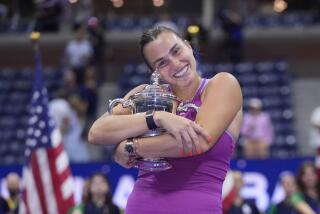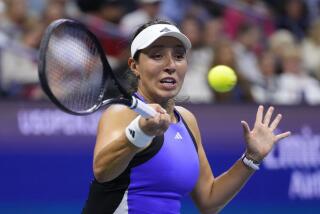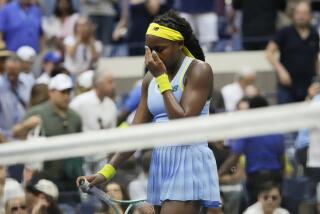Tennis : Grafâs Win May Be Turning Point for Women
Once, when three promising teen-agers reached the semifinals of a big tournament in Dallas, it was heralded as a landmark, a beginning of a new age in womenâs tennis.
It was good news because, after all, everyone was looking for successors to Chris Evert and Martina Navratilova. The three girls--Pam Shriver, Anne Smith and Tracy Austin--seemed destined to step up and become the leaders of a new tennis generation.
That was 1978.
Now itâs 1987. Shriver has never overtaken the big two. Smith made her name playing doubles but isnât even among the top 100 players in the world. Austin, 24, occasionally can be seen watching a tournament these days, but she hasnât played regularly on the tour since 1983.
So, Evert and Navratilova have fended off that first wave, and the second run of challengers, too. Since 1978, Navratilova has won seven more Wimbledon titles. Evert won two U.S. Open championships, one Wimbledon and five French Open crowns. Knowing this, it might be a bit premature to say that the beginning of the end for Navratilova and Evert has finally arrived. Whether Steffi Graf solidifies her hold on No. 1, or eventually falls by the wayside, however, last weekendâs tournament at Manhattan Beach now can be regarded as the true turning point of womenâs tennis.
Graf, an 18-year-old from West Germany, didnât even need to play her best tennis against Evert in last Sundayâs Virginia Slims of Los Angeles final. She beat Evert, 6-3, 6-4, and more importantly, caused a reshuffling at the top. For the first time since 1980, a player other than Navratilova or Evert holds the No. 1 spot in the rankings.
In years to come, people may talk about Manhattan Beach the same way they spoke about Dallas. For Graf, Navratilova and Evert, the Manhattan Beach tournament has meant a redefinition of roles, a new order in the hierarchy.
Hereâs a closer look at the revamped trio, heading into the U.S. Open later this month:
--Steffi Graf. She has won 50 of 51 matches in 1987, her lone defeat coming at the hands of Navratilova at Wimbledon. But the Graf of Manhattan Beach was not the same devastating player who blew away everyone at the Lipton International Players Championship last winter or at the Federation Cup competition.
Maybe itâs the new pressure. Instead of Graf stalking the veterans, Navratilova and Evert, itâs going to be the reverse in the U.S. Open at Flushing Meadow. Being No. 1 is a whole new game. Coping with those pressures could bother Graf more than the on-court games.
At 18, Graf is only going to get better. Her serve has become a weapon and with the addition of a top-spin backhand, 50 victories in 51 matches may become the norm for her, not the exception.
But for Graf, the pressures and demands of No. 1 will likely be her most persistent challenge.
--Martina Navratilova. Yes, even the best woman tennis player in the world, maybe best ever, canât miss five weeks and expect not to slip.
An ankle injury after Wimbledon forced the 30-year-old Navratilova to the sideline most of this summer. At Manhattan Beach, she wasnât really tested until meeting Evert in the semifinals. There, Navratilova played horribly, missing shots sheâd normally make in her sleep and botching easy volleys.
The last point told the story. Navratilova punched a relatively simple volley into the doubles alley to give Evert the victory. âI couldnât even get it in the doubles court,â Navratilova said in exaggeration.
Now, Navratilova has to fight off a rejuvenated Evert and a score of other challengers, while trying to recapture the top spot from Graf. Itâs a new position for Navratilova, who hasnât been anything less than No. 1 since November, 1985. The first chance to see how she adapts to the change will be at Flushing Meadow.
--Chris Evert. The way Evert, 32, is delivering her pitch these days sounds strangely like the one Jimmy Connors has been hawking for years.
These days, Evert speaks about having no pressure on her any more, saying she has already done everything there is to do in tennis.
Evert, not surprisingly, has adapted well to her departure from the big two. Actually, she isnât that far from No. 2. Against Navratilova, she is 2-2 in 1987, and her latest effort against Graf was nothing to be embarrassed about.
At Manhattan Beach, buoyed by an enthusiastic, supportive crowd, Evert played her best tennis of the year. In a sense, being written off is probably the best thing that could have happened to Evert. Sheâll thrive in the loud, rowdy atmosphere of Flushing Meadow and, ever so quietly, could pull herself back to No. 2.
Without much fanfare, the battle for control of menâs tennis was decided--at least for now--when the lawsuit filed more than two years ago by Volvo, ProServ and IMG against the Menâs International Professional Tennis Council (MIPTC) was thrown out by U.S. District Judge Kevin Thomas Duffy on Aug. 10.
The complaint had included federal antitrust claims and other state law claims. Duffy dismissed all federal antitrust claims by the plaintiffs, and also all claims by ProServ and IMG.
Volvoâs claims for breach of contract, fraud and defamation were dismissed with a chance to replead. Meanwhile, the counterclaim by MIPTC against Volvo, IMG and ProServ was left pending.
Five players in the worldâs top 20, including No. 3-ranked Stefan Edberg and No. 7-ranked John McEnroe, have entered the Volvo-Los Angeles tournament at UCLAâs L.A. Tennis Center, Sept. 21-27.
The three others are Brad Gilbert, No. 15; David Pate, No. 19, and Kevin Curren, No. 20.
At this point, the tour stop at San Francisco one week later has a stronger field. Ivan Lendl, Jimmy Connors, Henri Leconte, Tim Mayotte, Gilbert, Pate and Curren have committed to play at the Cow Palace. And McEnroe accepted a wild-card spot last week.
More to Read
Go beyond the scoreboard
Get the latest on L.A.'s teams in the daily Sports Report newsletter.
You may occasionally receive promotional content from the Los Angeles Times.











